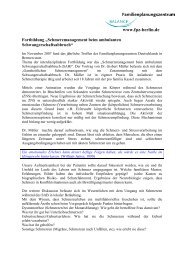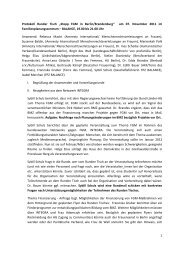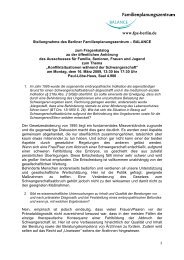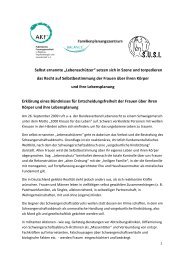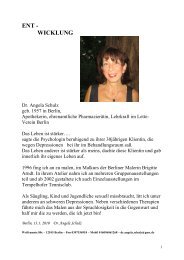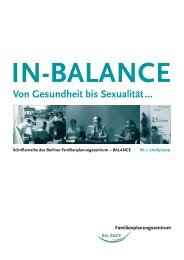Listening to African Voices - FPZ
Listening to African Voices - FPZ
Listening to African Voices - FPZ
Create successful ePaper yourself
Turn your PDF publications into a flip-book with our unique Google optimized e-Paper software.
Table 28: Proportion of women and men from groups and families practicing FGM/C (Cameroon)FGM/C takes place in my ethnic group (%) FGM/C has been taking place in my family (%)Yes No Don’t know Yes No Don’t knowWomen (n = 41) 30.8 66.7 2.6 7.7 87.2 5.1Men (n = 69) 7.2 88.4 4.3 2.9 95.6 1.5Total (n = 110) 15.7 80.6 3.7 4.7 92.5 2.8she did not know whether or not <strong>to</strong> circumcise her daughterand expressed the same attitude <strong>to</strong>wards the continuation ofthe practice. As the daughter is living in Cameroon and hadnever been <strong>to</strong> Germany, there was no chance of exploringthe girl’s situation further.5.5.4.4. Perception related <strong>to</strong> the practiceAlmost 80% of the participants emphasised that FGM/C wasa practice without any advantages. The remaining participantsassociated at least one benefit with the practice. Thereduction of sexual desire and the preservation of virginitywere the most commonly named advantages and named byrespectively 9% of the participants. There were no genderor age differences for the perception of positive outcomes ofFGM/C.5.5.4.5. FGM/C and religionThree Muslims and five Christians believed FGM/C <strong>to</strong> be requiredby their religion. Only one of these eight participants,however, a Muslim woman, came from a practicing family.Six participants declared they lack information regardingthe position of their religion <strong>to</strong>wards FGM/C. The remainingmajority of 87% saw no connection between FGM/C andtheir faith.5.5.4.6. Perception of disadvantages and knowledge of risksand consequencesWe noted a strong awareness of the risks and effects ofFGM/C among the Cameroonian immigrants: more than86% of the interviewees were able <strong>to</strong> cite one or severaldisadvantages of the practice. Infections and sexual problemsfor women were particularly well known consequencesof FGM/C and were each named by more than 30% ofthe participants. There were no gender or age differencesfor knowledge of the risks and negative consequences ofFGM/C.5.5.4.7. Knowledge of German law and attitudes <strong>to</strong>wards theabandonment of FMG/CThe greater part of the participants (82%) confirmed thatFGM/C is outlawed in Germany. The remaining participantswere uncertain: 17 men and women said that they were notinformed about the position taken by German law on thissubject, and two participants explained that the law abstainsfrom mentioning the practice. All participants from practicingfamilies were aware that FGM/C is a punishable act inGermany.Most members of the Cameroonian community stronglyadvocated the abandonment of FGM/C: 90% of the menand 95% of the women interviewed consider that FGM/Cshould be abolished. Only one man from a non-practicinggroup and family declared that FGM/C should continue. Fivemen – all but one also from non-practicing groups – saidthat it depended on the context and two women declaredtheir uncertainty vis-à-vis the continuation of the practice.5.5.5. The Gambia5.5.5.1. Socio-demographic profileThe Gambian community with about 450 members is the5th largest community from Sub-Saharan Africa in Hamburg.There are almost three times more men (333) than women(117). We managed <strong>to</strong> reach 90 participants, 57 men and 33women during the phase of quantitative interviews.The level of professional qualification is rather low amongthe interviewed Gambian immigrants and most of them workin low wage jobs. A large proportion of the Gambian womenare housewives. Almost 60% of the men of Gambian originare married <strong>to</strong> German spouses.5.5.5.2. Proportion of immigrant population concernedIn The Gambia, most ethnic groups practice FGM/C andthe prevalence rate is almost 80%. The only group with avery low prevalence rate are the Wolof whose girls undergoFGM/C only if a female spouse or female family member isfrom a practicing group and decides <strong>to</strong> initiate her daughter<strong>to</strong> the tradition. Among the Serer group, FGM/C is known<strong>to</strong> be practiced only moderately, with a prevalence rate of45%. All other larger groups (Diola, Fula, Mandingka etc.)have rates above 80%. FGM/C is practiced in all regionsof The Gambia, but <strong>to</strong> a lesser extent in the capital Banjul(45%) and in the Kerewan region (61%). The practice is lesscommon among mothers with secondary education (GambiaBureau of Statistics [GBoS] 2007).<strong>Listening</strong> <strong>to</strong> <strong>African</strong> <strong>Voices</strong> 55






